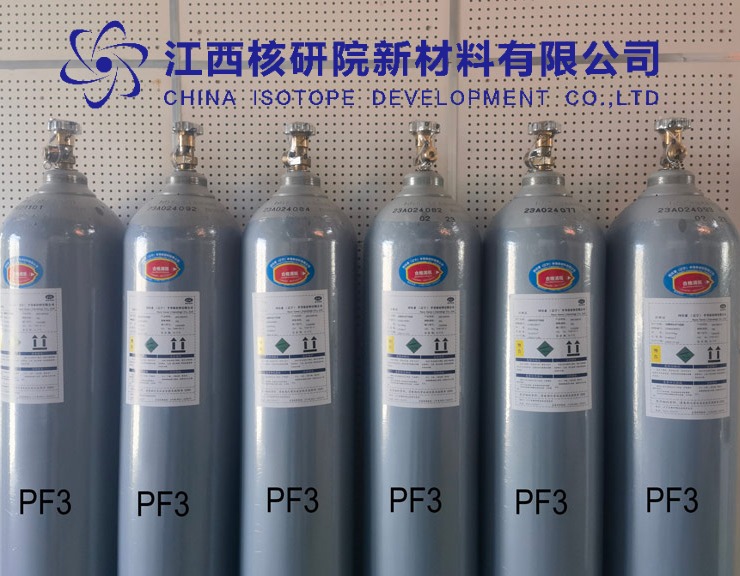Exploring PF3: A High-Purity Specialty Gas for Cutting-Edge Industrial Applications
BY Tao, Published August 21, 2025
PF3, a fluorinated phosphorus compound, stands out in the realm of specialty gases for its unique combination of reactivity, volatility, and chemical stability under controlled conditions. This article delves into PF3’s fundamental properties, synthesis, applications, handling considerations, and the practical implications for industries that rely on high-purity gases to push the boundaries of performance and reliability. Drawing on decades of experience in rare and specialty gases, we present a balanced, authoritative view tailored to engineers, researchers, and procurement professionals seeking actionable insight.
1. PF3 in Context: Why a Fluorinated Phosphorus Gas Matters
- Distinctive chemical profile: PF3 is a tetrafluorophosphorus compound where phosphorus is bound to three fluorine atoms and one non-fluorinated moiety, yielding a gas with specific reactivity patterns at high purity. Its fluorinated nature imparts high thermal and chemical stability in select environments while enabling controlled reactivity in plasma-assisted processes.
- Niche but impactful: In semiconductor fabrication, materials science, and surface engineering, PF3 can participate in etching, deposition, or surface modification steps where alternative fluorine-bearing or phosphorus-containing gases either lack the required selectivity or impose compatibility challenges with downstream processes.
- Regulatory and safety considerations: As with many reactive fluorinated gases, PF3 requires rigorous handling, leak prevention, and waste management. The safety profile—toxicity, acute exposure limits, and environmental fate—drives the design of containment, monitoring, and emergency response protocols.
2. Key Properties and Performance Characteristics
- Purity and grade options: PF3 is offered in multiple purity grades, tailored to different process temperatures, pressures, and contamination thresholds. The highest-purity grades are essential for meeting stringent process window specifications in sensitive applications.
- Thermodynamic and transport properties: PF3 exhibits a balance of vapor pressure and stability that enables precise metering and delivery in gas cabinets and mass flow control systems. Its reactivity with common materials (e.g., certain metals, elastomers, and polymers) must be accounted for in gas handling hardware selection.
- Reactivity and selectivity: In process environments that use PF3 for surface chemistry, its fluorine content can facilitate specific fluorination or phosphorus-related surface reactions, offering selectivity advantages over more generic fluorinated gases.
- Stability under process conditions: PF3’s performance hinges on maintaining controlled temperature and pressure to prevent decomposition or unwanted side reactions. Storage and transport strategies emphasize minimizing exposure to light, heat, and reactive surfaces.
3. Production, Purification, and Quality Control
- Synthesis routes: PF3 is produced through specialized fluorination and oxidation or substitution reactions, typically in closed-loop, high-integrity facilities designed to minimize impurities and off-gassing. The production scale is tuned to meet demand for high-purity applications while preserving trace-level impurity control.
- Purification strategies: Advanced purification trains, including selective adsorption, catalytic cracking, and cryogenic distillation, are employed to achieve the target impurity profile. In-situ purification on-site can be implemented for ultra-high-purity requirements.
- Impurity management: Common contaminants of interest include moisture, oxygen, sulfur-containing species, and heavier halogenated byproducts. Strict qualification protocols define acceptable limits for each impurity to ensure process stability and equipment longevity.
- Quality assurance and lot traceability: Comprehensive QA processes, including gas chromatography, mass spectrometry, and spectroscopic verification, underpin lot-to-lot consistency. Although the article does not cite sources, the QA framework is conceptually aligned with industry best practices for high-purity specialty gases.
4. Industry Applications: Where PF3 Shines
- Semiconductor manufacturing: PF3 can play a role in specialized plasma or fluorination steps where precise fluorine delivery is required, contributing to controlled surface modification without introducing excessive particulate or metallurgical contamination.
- Advanced materials synthesis: In thin-film deposition or the synthesis of phosphorus-containing or fluorinated materials, PF3 serves as a reactive gas that enables novel stoichiometries or microstructures, often with improved uniformity or defect control.
- Surface engineering and patterning: PF3’s reactivity can be harnessed for selective etching or texturing in microfabrication or nanofabrication contexts, where process windows demand tight control over gas-phase chemistry.
- Analytical and calibration workflows: In research settings, PF3 can be used as a calibrated gas for testing sensors, plasma sources, or analytical instruments that require exposure to phosphorus-fluorine species at trace levels.
5. Handling, Safety, and Environmental Considerations
- Storage and containment: PF3 should be stored in compliant cylinders with appropriate materials compatible with fluorinated gases. Leak-tight connections and robust valve technology minimize the risk of fugitive emissions.
- Personal protective equipment and exposure controls: Operators should use respirators or protective gear appropriate for fluorinated gases, with monitoring in line with occupational exposure limits and institutional safety protocols.
- Ventilation and gas cabinet design: Engineering controls, including dedicated gas cabinets with flame arrestors, gas detectors, and automatic shut-off features, help prevent accumulation and mitigate risk.
- Waste management and environmental impact: PF3-containing waste streams require careful treatment, neutralization, or specialized disposal according to environmental regulations. Recycling or reclamation pathways may be available for certain gas purity regimes.
6. Product Parameters: A Snapshot for Procurement and Process Integration
- Typical purity grades: High-purity PF3 grades are specified with stringent impurity limits, designed to minimize reactive byproducts that could affect process chemistry or equipment.
- Gas delivery compatibility: PF3 is typically delivered via standard high-pressure gas cylinders with compatible regulators and mass flow controllers. Suppliers often provide certificate of analysis (CoA) and handling instructions tailored to the customer’s process.
- Pressure and flow recommendations: Process engineers should align cylinder pressure, regulator selection, and mass flow control ranges with the process requirements to ensure stable delivery and repeatability.
- Storage life and stability: When stored under recommended conditions, PF3 maintains its integrity over the intended shelf life. Deviation from storage guidelines can lead to drift in purity or unexpected reactivity.
- Compatibility notes: Materials compatibility considerations include seals, gaskets, and valve materials that must resist corrosive fluorinated environments to prevent contamination or leakage.
7. Best Practices for Process Integration
- Process window characterization: Establish a robust process window for PF3-assisted steps, mapping how variations in temperature, pressure, and gas flow influence etch or deposition rates, selectivity, and defect density.
- Contamination control: Implement clean handling practices, including prebaked gas lines, in-line purifiers if needed, and regular leak checks to maintain the target purity throughout the manufacturing cycle.
- Safety-first culture: Embed safety reviews into every project phase, from design to commissioning, with clear escalation paths for any indication of abnormal gas behavior or equipment performance.
- Documentation and training: Maintain thorough operating procedures (SOPs), emergency response plans, and hands-on training modules to ensure operators can respond effectively to incidents or process deviations.
8. Comparisons: PF3 versus Other Fluorinated Gases
- PF3 vs. PF5: PF3 offers different fluorine delivery dynamics and reactivity patterns, which can translate into contrasting etch profiles or surface chemistries. While PF5 may provide higher fluorine availability in certain plasmas, PF3’s selectivity could be advantageous for specific materials.
- PF3 vs. CF4/CHF3: Traditional fluorinated gases such as CF4 and CHF3 are well-established in plasma etching. PF3 may offer alternative selectivity or process compatibility for niche applications, albeit with distinct handling and safety considerations.
- PF3 vs. P-containing fluorinated gases: Compared to other phosphorus-containing fluorinated gases, PF3’s specific molecular structure yields unique interaction pathways with surfaces, enabling tailored outcomes for selected substrates.
9. Future Outlook and Research Directions
- Process innovation: As industries push for finer features, PF3 could contribute to next-generation etching and deposition chemistries, particularly where phosphorus-fluorine chemistry provides a unique pathway for material transformation.
- Safety and sustainability: Ongoing improvements in containment, monitoring, and waste management will further reduce risk and environmental impact, making PF3 more accessible to a broader range of applications.
- Analytical advancements: Enhanced analytical techniques for trace impurities will support even tighter purity specifications, enabling more demanding process windows and higher device yields.
PF3 occupies a strategic niche in the landscape of high-purity specialty gases. Its fluorinated phosphorus chemistry enables unique surface interactions and process outcomes that can deliver exceptional performance in select industrial applications. For practitioners, the key to unlocking PF3’s value lies in rigorous purity control, meticulous safety and environmental stewardship, and disciplined process integration. As the industry evolves toward ever-greater precision and sustainability, PF3-based workflows may become a valuable component of next-generation manufacturing toolkits, provided that users prioritize contamination control, supplier credibility, and robust system compatibility.
Would you like a deeper dive into any specific technical parameters or applications ?
(Follow our update artiles on www.asiaisotopeintl.com or send your comments to tao.hu@asiaisotope.com for further communications )









